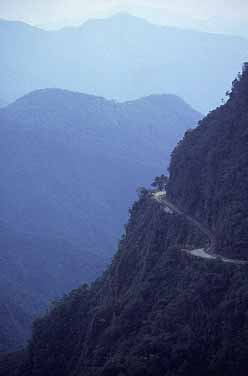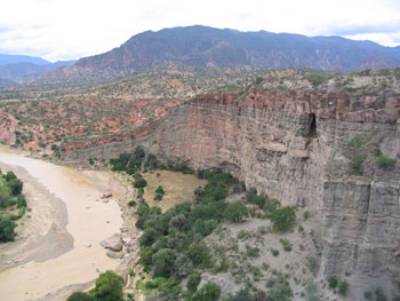Learn Spanish in Abroad - Climate of Bolivia
In general the climates in Bolivia are dictated mostly by altitude not latitude. The basic weather pattern of
Bolivia is the wet and the dry season, which happens at the same time country-wide. There are basically five separate climatic regions: The Andes and Altiplano, the Yungas and Chapare, the temperate valleys, the Chaco and the tropical lowlands of the upper Amazon basin.
Andes and Altiplano: :
In the highland region, located in the western third of the country, the weather does not change too dramatically from season to season. In general it’s a cold weather region because of its geographical location and the weather patterns that affect it. It has been said that in the Andes one can experience all seasons in one day. During the night, it’s cold like Winter, in the early morning, it’s like an early Spring, during the day it’s like a hot Summer and in the late afternoon it’s like a crisp Autumn day. The weather can be hot during the winter days (May to September) but can get bitterly cold at night, and well below freezing the further south you go. During the wet season (December to March) it will be cold when it rains but can be very plesant during the day when the sun is out and the nights can be mild.
|
|

|
The Yungas and Chapare:
The Yungas and Chapare regions are the eastern side of the Andes that are between the high Andes mountains and the upper Amazon basin. The geography for the most part is steep and rugged with a lot of jungle and whitewater rivers, which are abundant. This region is generally hot and humid and the climate does not change much during the year, except when the rains come during the wet season (December through March). During the dry season it rains less but it’s still hot and humid.
|
The Chaco Scrub and Plains:
In general the Chaco is known as the desert of Bolivia. It is generally flat with some rolling hills and valleys and a few rivers that drain the sparse landscape. Most of the plants have adapted to the very hot temperatures and low humidity that this region is known for. Short bushes, thorny branches, coarse grasses and cactus make up the majority of the plant life with a few scattered large trees. Since it’s so inhospitable few people live here and so the abundance of wildlife is varied and abundand. Hot, dusty and dry would describe the Chaco except in the rainy season when it’s hot and the dust turns to mud.
|
|

|
The Temperate Valleys:
These valleys are generally concentrated in the central and south-central part of the country have some of the most pleasant climates in the country. The geographic variety of the rolling hills and temperate climate made this region a favorite for the Spaniards during the colonial era. They characteristically don’t have the extremes temperature changes that occur daily or seasonally in other regions. The climate is mild and mediterranean-like with warm to hot days and pleasant night-time temperatures. This region is where the majority of the fruits and vegetables come from and which are distributed country-wide.
|
| The Tropical Lowlands:
These regions, which make up most of the Bolivian territory are composed of the upper Amazon basin in the north and northeast regions and the Parana basin in the east and south-east region. These tropical lowlands have a variety of ecosystems and in general they are hot and humid year round. During the rainy season (December to March) the rain is constant and torrential downpours are the norm. It will rain probably everyday during the wet season and flooding is a normal part of the process. The rainforest ecosystem depends on the seasonal flooding to function normally. Hot and humid would describe the lowlands’ climate. But, there are bitterly cold winds that come up (called Surazos) from Patagonia and the Argentine pampas that can drop the temperatures 30-40 degrees for days on end.
|
|
Seasonal Temperatures:
Once again, it depends on where you are in the country. During the dry season (the winter time) temperatures are generally colder and can be downright freezing in the highlands (and well below freezing the further south you go ) and it can be pleasant in the lowlands. The wet season (the summer time) brings hot temperatures and humid conditions to the tropics and cold and wet conditions to the highlands. In the middle altitudes (the valley region) temperatures don’t change in extremes like the highlands and lowlands. Winter has the most beautiful climate and temperatures in the valley regions.
Best Seasons for Travel:
There are primarily two seasons in Bolivia - the dry and the wet. The dry season is from May to October, the winter time months. The wet season is from November to April, the summer time months. It is coldest during the months of June to September and wettest from December to March. The dry season is best for travel due to the better road conditions and generally sunny skies and warm temperatures during the day. Travel to most regions of Bolivia is certainly possible year round but you must be prepared to deal with the seasonal changes (as in most countries that experience severe seasonal weather changes) and their effects on weather patterns and the subsequent roaand atmospheric conditions.
Rainfall:
The wet season country-wide is from late November to late March or early April, depending on where you are geographically. The quantity of rainfall varies from region to region, but the tropics get most of the rain by far. It can rain any day of the year in the Yungas and parts of the tropics as well. The highlands get very little rain in the winter except when it snows or hails, which are more frequent in the summer - wet season.
|
Go back to Learn Spanish in Bolivia
|

